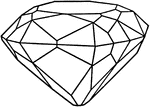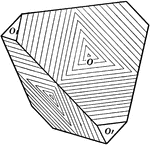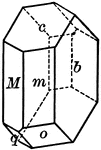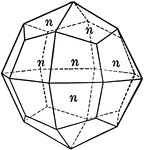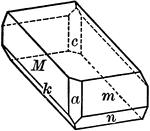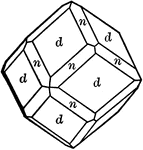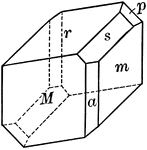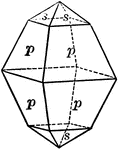
Sulphur
"Resinous luster. Color sulphur-yellow, varying with impurities to yellow shades of green, gray, and…

Sulphur
"Resinous luster. Color sulphur-yellow, varying with impurities to yellow shades of green, gray, and…

Chalcocite
"Orthorhombic. Usually in small tabular crystals with hexagonal outline. Striated parallel to the brachy-axis.…

Marcasite
"Orthorhombic. Crystals commonly tabular parallel to basal plane, showing also short prisms and low…
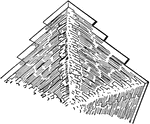
Marcasite
"Orthorhombic. Crystals commonly tabular parallel to basal plane, showing also short prisms and low…

Arsenopyrite
"Orthohombric. Usually in tabular diamond-shaped crystals, formed by a short prism terminated by low…
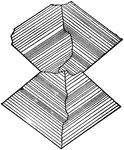
Arsenopyrite
"Orthohombric. Usually in tabular diamond-shaped crystals, formed by a short prism terminated by low…
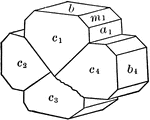
Bournonite
"Orthohombric. Crystals usually short prismatic to tabular. Sometimes quite complex with many prism,…

Quartz
"Terminated usually by a combination of a positive and negative rhombohedron, which often are so equally…

Quartz
"Terminated usually by a combination of a positive and negative rhombohedron, which often are so equally…
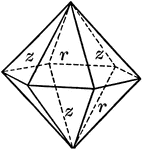
Quartz
"Terminated usually by a combination of a positive and negative rhombohedron, which often are so equally…
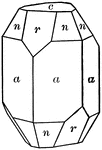
Corundum
"Hexagonal-rhombohedral. Crystals usually prismatic in habit or tapering hexagonal pyramids." —…

Corundum
"Hexagonal-rhombohedral. Crystals usually prismatic in habit or tapering hexagonal pyramids." —…

Hematite
"Hexagonal-rhombohedral. Crystals usually thick to thin tabular. Basal planes prominent, often showing…
Hematite
"Hexagonal-rhombohedral. Crystals usually thick to thin tabular. Basal planes prominent, often showing…
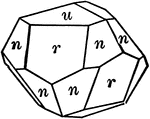
Hematite
"Hexagonal-rhombohedral. Crystals usually thick to thin tabular. Basal planes prominent, often showing…
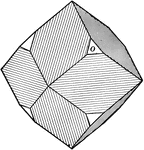
Magnetite
"Isometric. Octahedral habit, sometimes twinned octahedrons. Dodecahedron at times, either alone or…
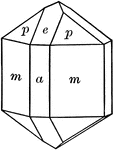
Cassiterite
"Tetragonal. Common forms are prisms and pyramids of first and second orders." — Ford, 1912
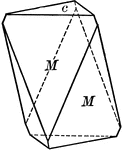
Calcite
"Hexagonal-rhombohedral. Crystals are very varied in habitat, often highly complex. Over 300 different…

Calcite
"Hexagonal-rhombohedral. Crystals are very varied in habitat, often highly complex. Over 300 different…
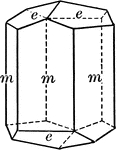
Calcite
"Hexagonal-rhombohedral. Crystals are very varied in habitat, often highly complex. Over 300 different…

Calcite
"Hexagonal-rhombohedral. Crystals are very varied in habitat, often highly complex. Over 300 different…

Calcite
"Hexagonal-rhombohedral. Crystals are very varied in habitat, often highly complex. Over 300 different…
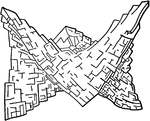
Dolomite
"Hexagonal-rhombohedral. Crystals are usually the unit rhombohedron (cleavage rhombohedron). Faces often…
Aragonite
"Orthorhombic. Acicular pyramidal; consisting of a prism terminated by a combination of a very steep…

Aragonite
"Orthorhombic. Tabular; consisting of prominent brachypinacoid faces modified by a prism and a low brachydome."…

Cerussite
"Habit varied and crystal show many forms. Crystals often tabular parallel to brachypinacoid." —…
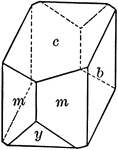
Orthoclase
"Monoclinic. Crystals are usually prismatic in habit and have as prominent forms, clinopinacoid, base,…
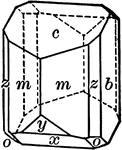
Orthoclase
"Monoclinic. Crystals are usually prismatic in habit and have as prominent forms, clinopinacoid, base,…
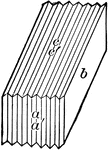
Albite
"Triclinic. Twinning very common, according to the albite law and evidenced by fine striation lines…

Amphibole
"Monoclinic. Crystals prismatic in habit; the prism faces make angles of 55 and 125 degrees with each…
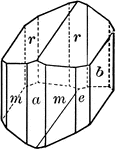
Amphibole
"Monoclinic. Crystals prismatic in habit; the prism faces make angles of 55 and 125 degrees with each…
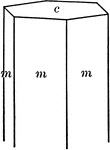
Beryl
"Hexagonal. Strong prismatic habit. Frequently vertically striated and grooved. Forms usually present…
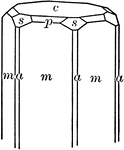
Beryl
"Hexagonal. Strong prismatic habit. Frequently vertically striated and grooved. Forms usually present…
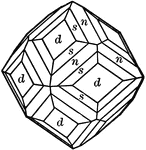
Garnet
"Isometric. Common forms dodecahedron amd trapezohedron, often in combination. Hexoctahedron observed…
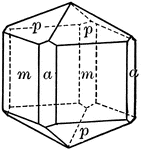
Wernerite
"Tetragonal; tripyramidal. Crystals usually prismatic. Prominent forms are prisms of the first and second…

Wernerite
"Tetragonal; tripyramidal. Crystals usually prismatic. Prominent forms are prisms of the first and second…
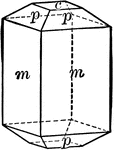
Vesuvianite
"Tetragonal. Prismatic in habit. Often vertically striated. Common forms are prisms of first and second…
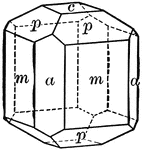
Vesuvianite
"Tetragonal. Prismatic in habit. Often vertically striated. Common forms are prisms of first and second…

Zircon
"Tetragonal. Crystals usually show a simple combination of prism and pyramid of the first order. The…

Topaz
"Orthohombic. In prismatic crystals terminated by pyramids, domes, and basal plane." — Ford, 1912
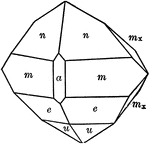
Datolite
"Monoclinic. Habit varied. Crystals usually nearly equidimensional in the three axial directions and…

Epidote
"Monoclinic. Crystals are often much elongated parallel to the ortho-axis with a prominent development…

Calamine
"Orthohombic, hemimorphic. Crystals usually tabular parallel to the brachypinacoid. They show prism…
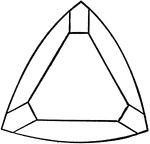
Tourmaline
"Hexagonal-rhombohedral; hemimorphic. Crystals usually prismatic, vertically striated. A triangular…

Tourmaline
"Hexagonal-rhombohedral; hemimorphic. Crystals usually prismatic, vertically striated. A triangular…
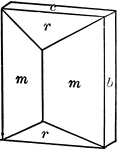
Staurolite
"Orthohombic. Habit prismatic, showing usually a combination of prism with large angle, brachypinacoid,…
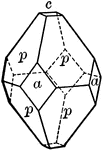
Apophyllite
"Tetragonal. Usually shows a combination of prism of second order, pyramid of first and basal plane."…

Stilbite
"Monoclinic. Uniform in cruciform twins. Commonly tabular parallel to clinopinacoid. Crystals usually…
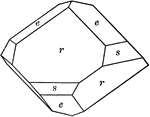
Chabazite
"Hexagonal-rhombohedral. Common form is the simple rhombohedron, r, having nearly cubic angles. May…
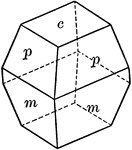
Titanite
"Monoclinic. Crystals varied in habit. Often with prominent basal plane which is steeply inclined and…
